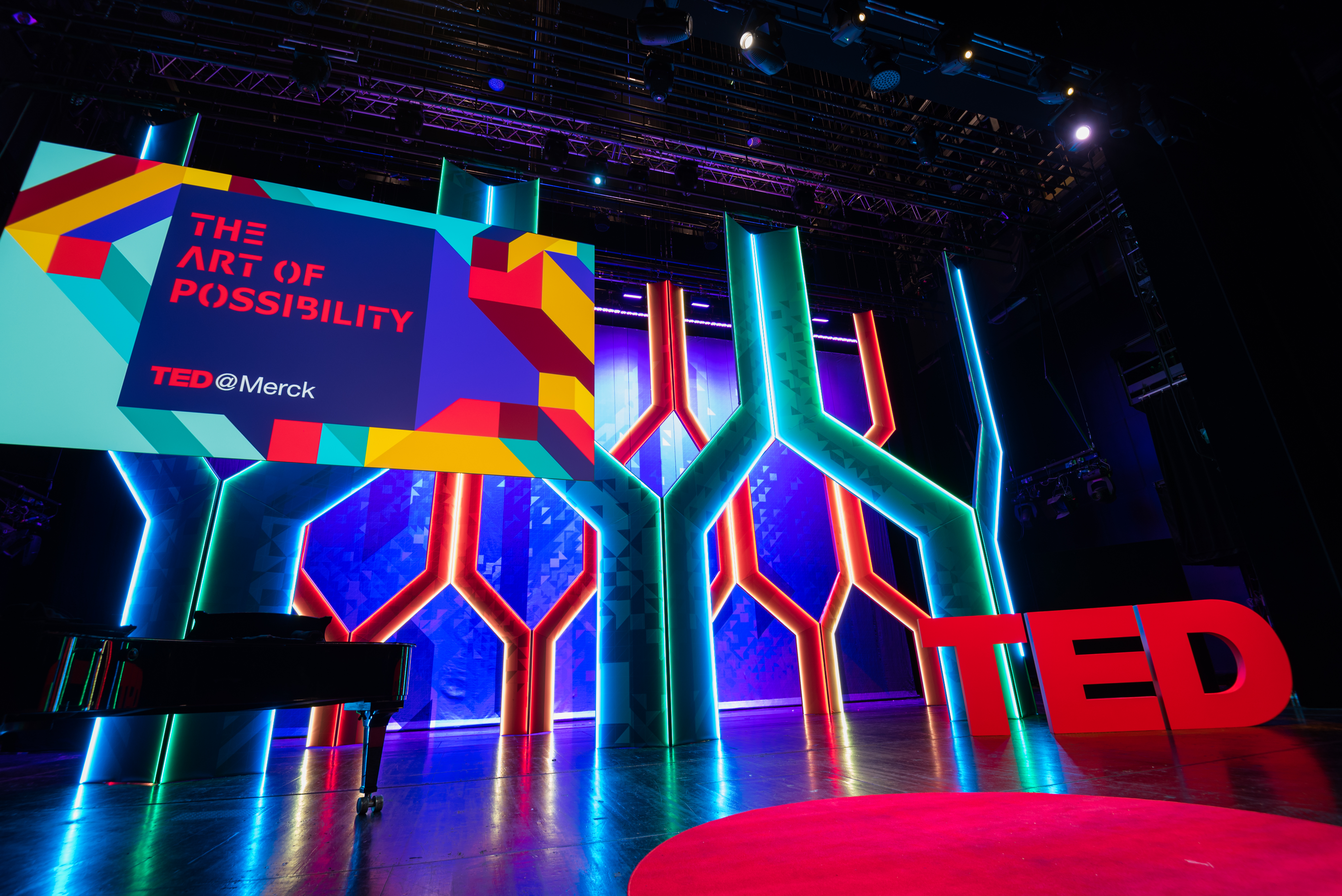
For a second year, TED and Merck KGaA, Darmstadt, Germany, have partnered to explore the art of possibility. (Photo: Richard Hadley / TED)
The possibilities life affords us are endless. We can find them everywhere, at the micro and macro levels and across all fields. Do you see them? Look closer: they are there every time we use our curiosity and imagination to explore and try new things.
For a second year, TED and Merck KGaA, Darmstadt, Germany, have partnered to explore the art of possibility. At this year’s TED@Merck KGaA, Darmstadt, Germany, hosted by TED’s international curator Bruno Giussani at Staatstheater Darmstadt on November 26, 2018, a lineup of 13 visionaries, dreamers and changemakers shared the possibilities of past, present and future.
After opening remarks from Stefan Oschmann, Chairman of the Executive Board and CEO of Merck KGaA, Darmstadt, Germany, the talks of Session 1 kick off.
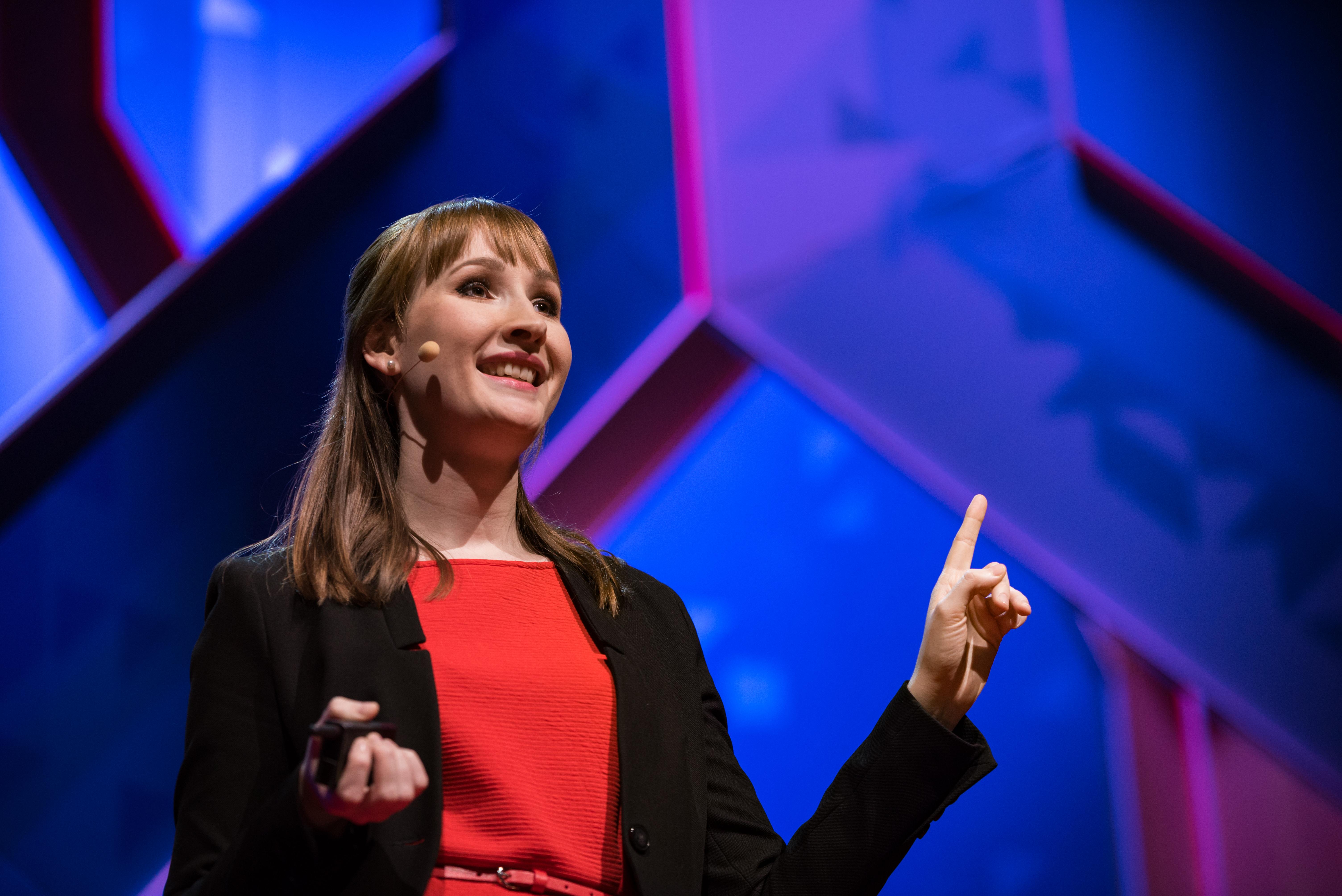
Sharks could be our newest weapons against cancer, says antibody researcher Doreen Koenning. She shares her work at TED@Merck KGaA, Darmstadt, Germany. (Photo: Richard Hadley / TED)
Can sharks help us fight cancer? The time-worn cliché, “If you hear hoofbeats, think of horses, not zebras,” is meant to remind us that the most obvious solution is usually the correct ones. Yet antibody researcher Doreen Koenning has dedicated her career to doing exactly the opposite — and in the process, she’s uncovered surprising weapons that may help us fight cancer. Koenning studies sharks — specifically, their antibodies, which are unusually stable and robust, and which interact with a wide variety of complex molecules. What does this have to do with cancer? Medicines made from human antibodies help us battle cancer — but since they blend into our immune system so well, it’s difficult to track their side effects. Shark antibodies, by contrast, stand out like a sore thumb. Because of this, they could become a valuable tool for neglected diseases and clinical drug trials — and potentially create a new breed of cancer medicines. In the end, Koenning reminds us that we can find useful molecules in many other species, each of them having very special traits. So our search for “zebras” shouldn’t stop at the shark tank.
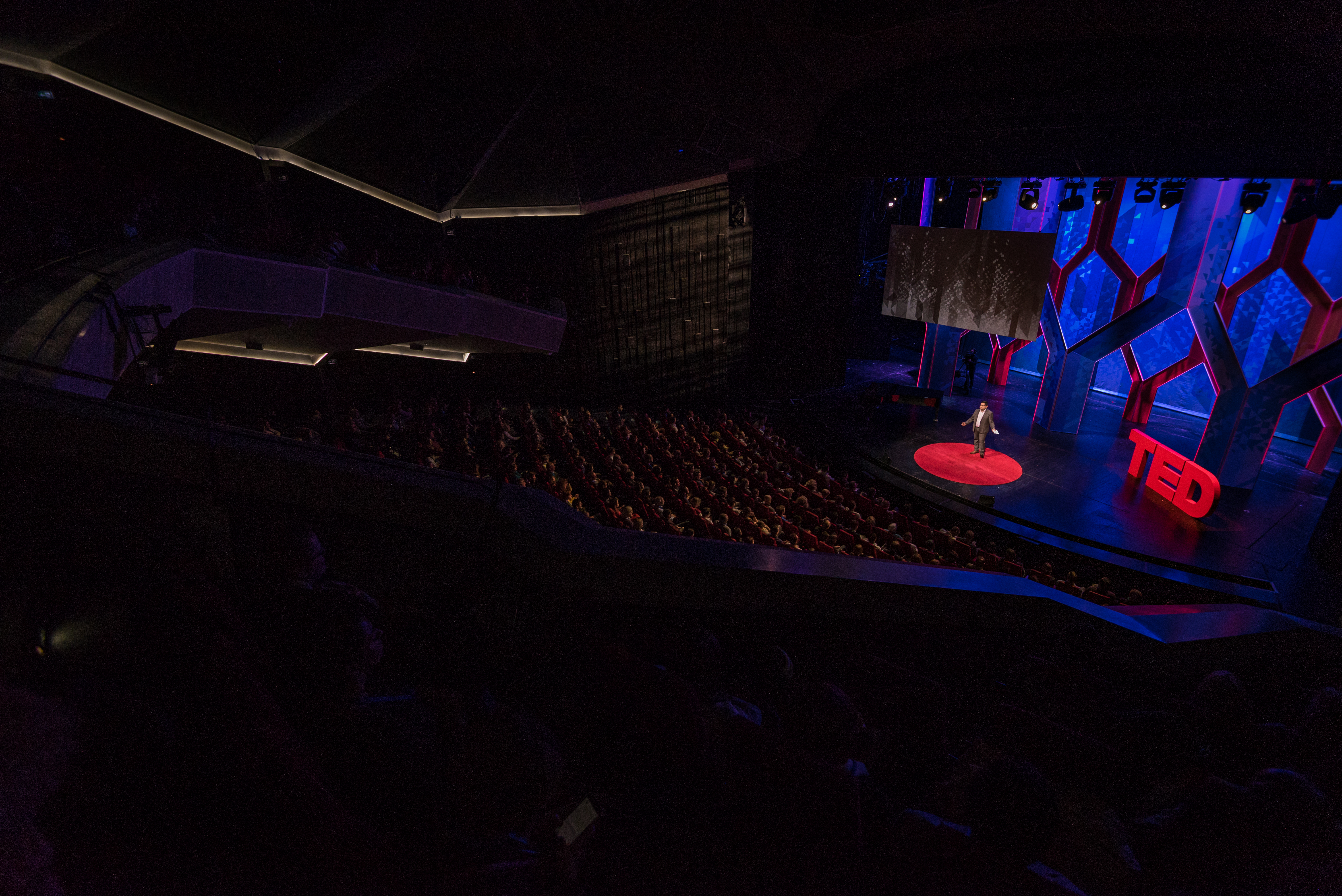
By bridging immunology and biology, we can engineer vaccines that evolve alongside the superbugs, says pharmacist Vikas Jaitely. He speaks at TED@Merck KGaA, Darmstadt, Germany. (Photo: Richard Hadley / TED)
We can fight antibiotic-resistant superbugs with a new class of vaccines. We urgently need to revamp our approach to developing solutions for bacterial diseases, says pharmacist Vikas Jaitely. Deadly superbugs like MRSA and Clostridium difficile are quickly evolving to resist antibiotics by continuously mutating their genes and even borrowing stronger DNA from other bacteria. Although medical science is trying to keep up, these strains are progressing at a much faster rate than our antibiotics; by 2050, superbugs could claim up to 10 million lives a year globally. Jaitely proposes a new source of help: learning directly from the bacteria and developing what he calls an “ecosystem of evolving vaccines” that can be rapidly modified to target ever-changing bacteria strains. Jaitely says that by modeling superbug behavior and tracking the most probable adaptations (similar to how we approach the flu virus), we can engineer vaccines that evolve alongside the superbugs, functioning as protective shields in our bodies. By “bridging immunology and biology,” he concludes, “we can remove these bugs’ superpowers through the power of our own immune systems, fully trained by these new vaccines.”
What your breath could reveal about your health. There’s no better way to stop a disease than catching and treating it early, before symptoms show. That’s the whole point of medical screening techniques like radiography, MRIs and blood and tissue tests. But there’s a medium with overlooked potential for medical analysis: your breath. Technologist Julian Burschka shares the latest in the art of breath analysis — the screening of the volatile organic compounds we exhale — and how it can be used to better understand the biochemical processes happening inside a patient’s body. Burschka explains how research on breath analysis has skyrocketed recently, and that there’s substantial data suggesting that diseases like Alzheimer’s, diabetes and even colon cancer can be detected in our breath. As the technology matures, the decision of whether or not to treat a disease based on early detection will still be debated, Burschka says. But it’s opening up exciting new possibilities like the creation of longitudinal data that could track the same patient over her lifetime, enabling doctors to detect abnormalities based on a patient’s own medical history, not the average population. “Breath analysis should provide us with a powerful tool not only to proactively detect specific diseases, but also to predict and ultimately prevent them,” Burschka says.
The possibilities of dynamic lighting. Light is all around us, yet many of us don’t realize how much of an effect it has on our behavior and productivity. Lighting researcher Sarah Klein believes we can use lighting to improve our daily lives. Lighting is often chosen with installation costs in mind — not designed to help us feel our best. Klein thinks we should change that approach and make it work with our biological needs. She suggests a “dynamic light system” — a network of adjustable, condition-specific LED lights that NASA uses to help their astronauts get the right amount of sleep. This kind of solution isn’t just for astronauts — it can be useful back on Earth, too, Klein says. For example, a dynamic light system could help travelers cope with jetlag on airplanes and enable people to heal faster in hospitals. Now that we know the impact that light has on us, she says, “We can create a healthier environment for our colleagues, our friends, our families — and ultimately ourselves.”
The impact of a TED Talk, one year later. In a personal, eye-opening talk at last year’s TED@Merck, patient advocate Scott Williams highlighted the invaluable role of informal caregivers — those friends and relatives who go the extra mile for their loved ones in need. More than a million views later, Williams is back on the TED stage, discussing the impact of his talk both within Merck KGaA, Darmstadt, Germany, and on the general public. Since the talk, the company has launched a program called Embracing Carers that supports informal caregivers, and people from around the world have reached out to Williams to share their stories and perspectives. Now, Williams and Embracing Carers are partnering with like-minded organizations, such as Eurocarers and the American Cancer Society (and actor Rob Lowe!), to share tools and resources. “This journey generated interest and brought people together,” Williams says. “It sparked a dynamic conversation about the situation of carers.”
A grassroots healthcare revolution in Africa. The last several decades have brought revolutionary advances in medical technology — and yet, according to the World Health Organization, half of the world’s population still can’t get basic health care. How can we fix this glaring gap? Inclusive health care advocate Boris A. Hesser believes that the answer lies in community pharmacies, and developing them into bonafide centers of care. Throughout Africa, for example, small pharmacies can be logical local service points for basic medical care and long-term patient outcomes — if they can access the tools they need. Hesser’s team has already built five basic, sustainable facilities around Nairobi that provide preventative care, affordable medication and even refrigeration for medicines. It’s one step in bringing affordable health care to everyone, everywhere.
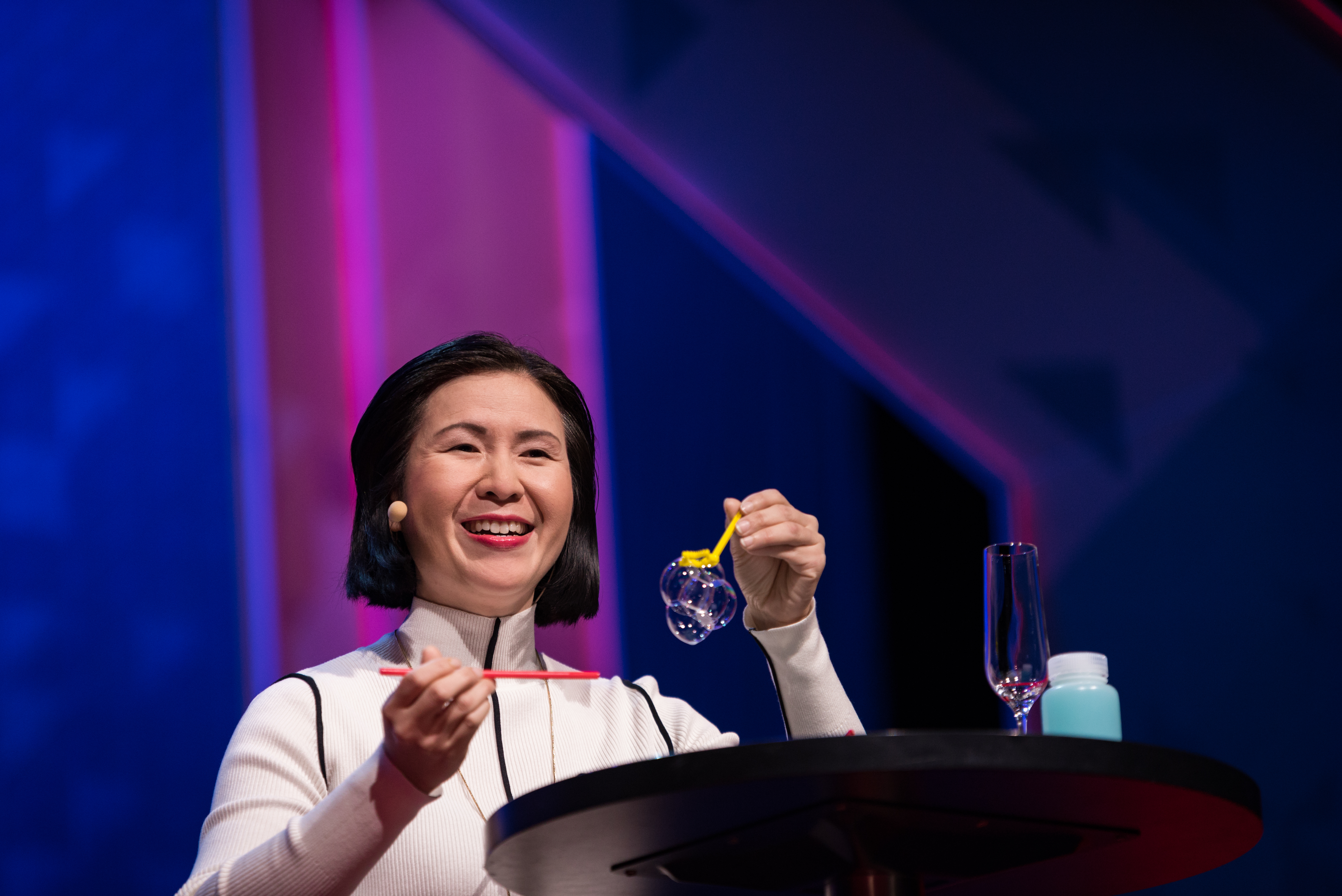
Scientist Li Wei Tan is passionate about bubbles. At TED@Merck KGaA, Darmstadt, Germany, she shares the magic of these soapy spheres. (Photo: Richard Hadley / TED)
The wonderful, surprisingly scientific world of bubbles. Ink formulation scientist Li Wei Tan wants to burst your bubble. It’s actually her job to do just that; when you hold a smartphone, it’s her work that helps give the screen such a crisp, clear quality, by removing the micro- and nano-sized bubbles that want to live in the ink beneath the screen. Tan knows all about the secret world of bubbles — how to remove tiny ones and create the giant bubbles that may have fascinated you as a child — and shares the magic of these soapy spheres. Bubbles are mathematical marvels because they’re constantly seeking geometric perfection, which gives them their shape, Tan says. (Did you know six connected bubbles form a cube in the center?) And these spectacular orbs have influenced industries from manufacturing and shipping (where boats are trying to mimic the bubble-producing tendencies of swimming penguins) to medicine — even down to the tiny bubbles in champagne. “As a scientist who is passionate about bubbles,” she says, “I love to see them, I love to play with them, I love study them, and also I love to drink them.”
Why multitasking works — if we slow it down. “To do two things at once is to do neither,” so the saying goes. But economist and journalist Tim Harford thinks that doing two things at once — or three or even four — is exactly what we should be going for, so long as we slow down to do them right. Harford calls this concept “slow-motion multitasking,” and it’s a pattern of behavior common in highly creative people of all stripes — from Einstein and Darwin to Michael Crichton and Twyla Tharp. Slow-motion multitasking is “when we have several projects in progress at the same time, and we move from one to the other and back again as the mood takes us or the situation demands,” he says. The benefits of this approach are manifold. For instance, creativity often comes from moving an idea out of its original situation and into a new context. As Harford puts it: “It’s easier to think outside the box if you spend some time clambering from one box to another.” What’s more, learning to do one thing may help you do something else. Harford gives the example of medical trainees who became significantly better at analyzing and diagnosing images of eye diseases after spending time studying art. And by balancing several fulfilling projects at once, Harford explains, you’re less likely to get stuck: a setback on one project presents itself as an opportunity to work on another. So how do you keep all these creative pursuits straight in your head? Harford suggests storing related information in separate boxes — whether these are actual physical boxes or digital folders — that can be easily accessed when inspiration strikes. “We can make multitasking work for us, unleashing our natural creativity,” Harford says. “We just need to slow it down.”
Breaking down cultural barriers — with cake. Materials scientist Kathy Vinokurov says that when faced with cultural boundaries in unfamiliar environments, we should be bold and take the first step to bridge those gaps. Born in Russia, Vinokurov moved to Israel as a teenager, where she says she built an imaginary wall between her and her classmates. Fast forward to a new job in Germany later in life and Vinokurov realized she had done the same thing at her workplace. While we can’t control the perceptions others have of us, Vinokurov says, we can control how we communicate and share with those around us. She suggests that when we’re in new settings, we can ease cultural barriers by showing up as our full, authentic selves — and, perhaps, bringing sweet treats from home, like cake. “This opens up the possibility to talk about all the bricks that, if not addressed, may build that wall,” Vinokurov says. While not everyone will immediately open up, she encourages us to spark conversation and “cultural barriers will start to melt away.” Though the tensions of a new workplace can be daunting, sometimes it really is as easy as pie.
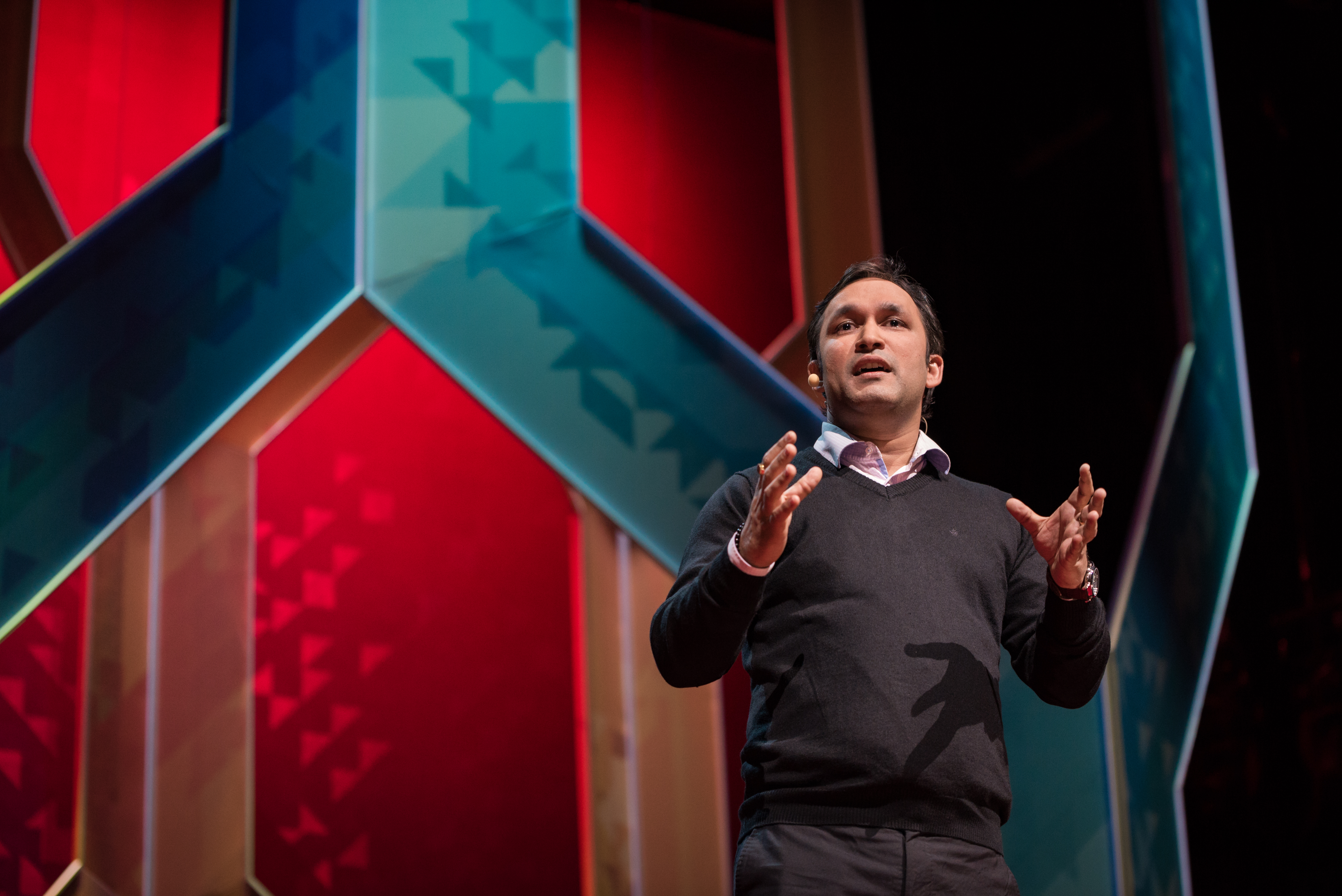
By combining AI and blockchain, we could enter an era where we render all data — published and unpublished — searchable and shareable, says complexity specialist Gunjan Bhardwaj. He shares his vision of the future at TED@Merck KGaA, Darmstadt, Germany. (Photo: Richard Hadley / TED)
Technological tools for mining medical data. Complexity specialist Gunjan Bhardwaj begins his talk with a grim statement: “All of us in this room have a friend or a loved one who has suffered from a life-threatening disease.” When faced with this reality, we find ourselves trying to sort through a mountain of medical data to figure out what therapies are available, pinpoint where we can get them and identify the best experts to help. And this mountain is constantly growing; according to a study by Peter Densen: at the present rate, medical knowledge will double itself every 73 days in the year 2020. Doctors and researchers — let alone patients and their families — will find it impossible to attain a cohesive view of this “deep, dense and diverse” data. Bharwaj identifies two potential technological solutions to this problem: artificial intelligence and blockchain. An AI trained in the specialized language of medical science could crawl data and enable users to answer their most pressing questions. And using blockchain to encrypt siloed, proprietary and otherwise unavailable data could allow researchers to share their unpublished findings more securely, sparking innovation. By combining AI and blockchain, we could enter an era where we render all data — published and unpublished — searchable and shareable. “That era is now,” Bharwaj says.
The self-assembling circuits of the future. We’ve all experienced the frustration of an old computer or smartphone grinding to a halt. It’s the circuits to blame. In time, if we don’t develop better hardware for evolving tech like facial recognition and augmented reality, we could hit a point where the mind-blowing potential of software may be limited, warns developer Karl Skjonnemand. Right now, much of our technology runs thanks to transistors — big, hulking machines that after 50 years of continuous reinvention are now smaller than a red blood cell. But Skjonnemand says that we’re reaching their physical limits, while still needing to go smaller. It’s time for a totally different, robust and cost-effective approach inspired by nature and brought to life by science: designing self-assembling materials after membranes and cell structures in order to continue with the spectacular expansion of computing and the digital revolution. “This could even be the dawn of a new era of molecular manufacturing,” says Skjonnemand. “How cool is that?”
What should electric cars sound like? Renzo Vitale designs an automotive system that few of us consider — the sonic environments cars produce. Electric cars, with their low audio footprints, offer some welcome silence in our cities — as well as new dangers, since they can easily sneak up on unsuspecting pedestrians. So what kind of sounds should they make to keep people safe? Instead of an engine sound, Vitale explores “sonic textures that are able to transmit emotion … connecting feelings and frequencies” that “speak to the character and identity of the car” — or “sound genetics.” In practice, this could mean a car that sounds like a harmonious synthesizer reaching crescendo as it accelerates. Vitale is also an artist and a performer, using his automotive environments as blueprints for mind-boggling installations and musical scores. To close of his talk, he plays selections from his piano albums, Storm and Zerospace.
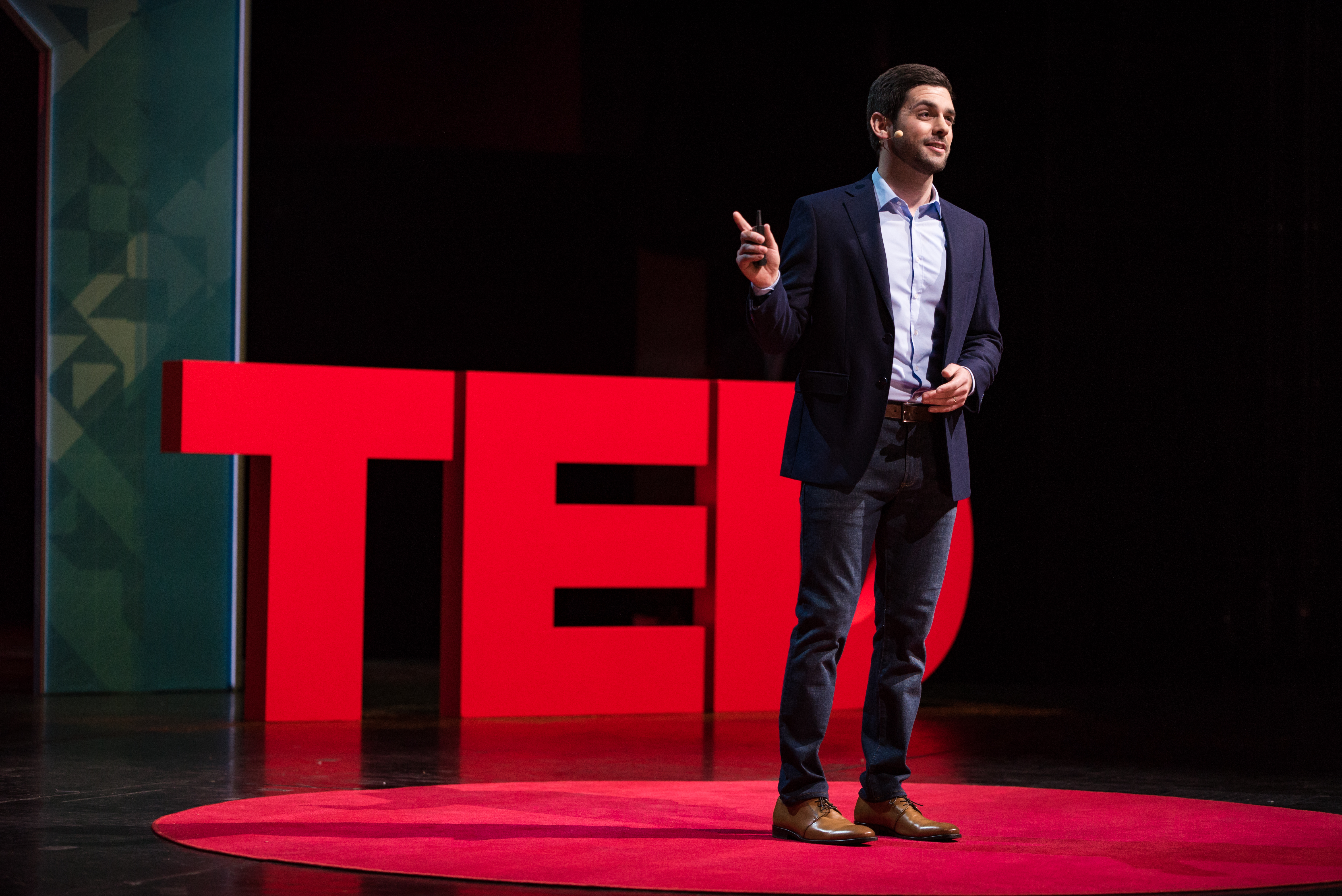
At TED@Merck KGaA, Darmstadt, Germany, Daniel Sherling shares his work bringing the joy of science to American kids who don’t have access to high-tech facilities. (Photo: Richard Hadley / TED)
How a shipping container sparks students’ curiosity. “How can students get excited about science if they don’t have access to the resources that actually make science fun?” asks science education promoter Daniel Sherling. With his team at MilliporeSigma, Sherling transformed a yellow shipping container into a “Curiosity Cube” — a mobile science lab meant to create an engaging, dynamic learning environment. Inside the Curiosity Cube, students can find technology like programmable robots, 3D printers, interactive microscopes, virtual reality and more. The Cube is strapped to a trailer and travels throughout North America, visiting schools that lack the resources for real hands-on science experiments. This way, he says, interactive science can be brought to the students who need it most. And on weekends, families and students can find the Cube in large city centers or public spaces. It’s open to anyone interested in learning more about science — no matter their age. “If we can expose students to the wonders of science, if we can get them just that much more excited for science class the next day, we truly believe we can have a domino effect,” says Sherling. “Because what students need is the opportunity to see and experience how awesome science is. To feel safe to learn, to build their confidence, and most importantly to have their curiosity sparked.”
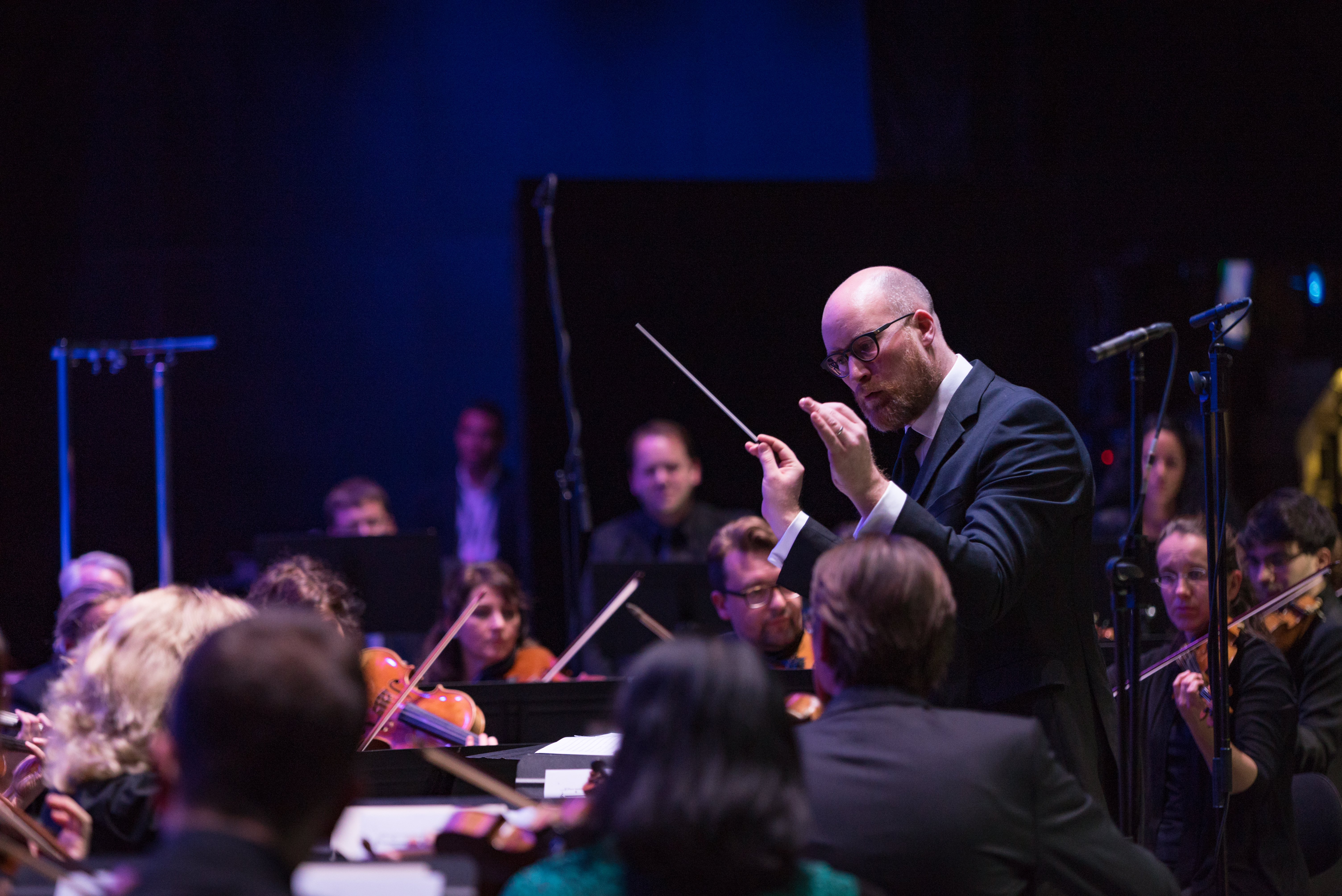
Deutsche Philharmonie Merck wrapped up the evening with a piece composed by Ben Palmer in 2018 to celebrate the 350th anniversary of Merck KGaA, Darmstadt, Germany. (Photo: Richard Hadley / TED)
“Part II. The Journey Through Time.” After closing remarks from Belén Garijo, CEO Healthcare, at Merck KGaA, Darmstadt, Germany, Deutsche Philharmonie Merck wraps up the evening performing a piece composed by its conductor Ben Palmer in 2018 to celebrate the 350th anniversary of the company. This is followed by a second piece by Mikhail Glinka, “Ruslan and Lyudmila,” an overture based on a poem by Pushkin, providing a contemplative melody with toiling bravado, soaring strings and notes of inspiration — which one could imagine as the sounds of a working mind struck by brilliance.